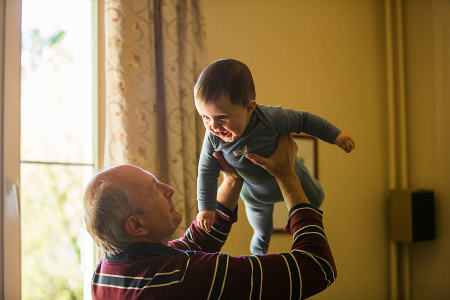We ask you, humbly: don't scroll away.
Hi readers, it seems you use Catholic Online a lot; that's great! It's a little awkward to ask, but we need your help. If you have already donated, we sincerely thank you. We're not salespeople, but we depend on donations averaging $14.76 and fewer than 1% of readers give. If you donate just $5.00, the price of your coffee, Catholic Online School could keep thriving. Thank you.Help Now >
Illicit Drugs: A Gross Domestic Product
FREE Catholic Classes
Global Scourge Continues
STOCKHOLM, Sweden, SEPT. 4, 2005 (Zenit) - Around 200 million people have used drugs at some point in the last 12 months. This was one of the findings presented June 29 in the 2005 World Drug Report, issued by the U.N. Office on Drugs and Crime.
The UNODC report, which covers data up to 2003, estimates that there are 160 million marijuana users. The number of those using amphetamines and ecstasy, termed as ATS users by the report, is 26 million and 8 million, respectively. The number of opiate users is estimated to be around 16 million. Cocaine users number almost 14 million.
Although countries indicating rising levels of drug consumption continue to outnumber those with falling levels of drug use, the proportions have shifted in recent years in a slightly more positive direction. In 2000, 53% of all reporting countries saw rising levels of drug use. This fell to 44% in 2003.
The report noted that the abuse of synthetic drugs everywhere has declined. The abuse of opium and heroin has stabilized and started to decline in a number of major consuming nations, for example in Western Europe. The trend toward cocaine use has lost its momentum and has started to decline in the foremost consumer country, the United States. But the consumption of marijuana is widespread.
We ask you, humbly: don't scroll away.
Hi readers, it seems you use Catholic Online a lot; that's great! It's a little awkward to ask, but we need your help. If you have already donated, we sincerely thank you. We're not salespeople, but we depend on donations averaging $14.76 and fewer than 1% of readers give. If you donate just $5.00, the price of your coffee, Catholic Online School could keep thriving. Thank you.Help Now >
Lucrative trade
The UNODC report tries to estimate the monetary value of the illicit drug industry. "The overall size of the illicit drug industry is known to be huge," the report states. But its clandestine nature makes its size hard to estimate.
The value of the global illicit drug market for 2003 was estimated at $13 billion at the production level, $94 billion at the wholesale level, and $322 billion at the retail level. "Drug revenues account for 0.9% of the global gross domestic product," explained the UNODC executive director, Antonio Costa, during the report's presentation in Stockholm.
The report calculated that in 2003, the sale of illicit drugs, measured at wholesale prices, was equivalent to 12% of the value of the global export of chemicals, and 14% of world agricultural exports.
The largest market, according to these estimates, is cannabis (marijuana) herb, with a retail market size of $113 billion. This is followed by cocaine, $71 billion; the opiates, $65 billion; and cannabis resin, $29 billion. The ATS markets amount to $44 billion. UNODC is reasonably confident about the estimates on opiates, cocaine and ATS, but the degree of certainty is far lower for cannabis, notably for cannabis herb, as information for production and consumption of this substance is highly contradictory.
Efforts by authorities to combat the drug trade have had some success. The 95 countries that reported to the UNODC cited a fourfold increase in the number of drug seizures between 1985 and 2003.
More than half of these were seizures of cannabis, about a quarter involved opiates, and amphetamines accounted for another 10%. In the last decade, the most significant trend has been the increase in the number of seizures of amphetamine-type stimulants. In 2003, however, this trend reversed sharply, mainly as a result of the decline in ATS seizures from Thailand following a major crackdown on the drugs in the previous year.
Eyes on Afghanistan
In contrast, the proportion of seizures of opiates rose significantly in 2003. This mainly reflects the revival of opium production in Afghanistan and more seizures in surrounding countries.
The report calculates that around 87% of the opium for the illicit market is produced in Afghanistan. This has largely offset the strong declines reported from Myanmar (Burma) and Laos in recent years.
In fact, the report commented that what happens in Afghanistan will determine the size and development of the world's main opiate markets. Things could improve in the coming year, as, according to UNODC, the government is gradually strengthening its control over the country and those involved in the opium business. In the meantime, the country's last opium harvest is still finding its way to the consumer markets of Europe and other regions.
The number of people addicted to opiates, around 16 million, is lower than for some other substances, but the number who are actually treated for opiate abuse (1.3 million) is higher than for any other substance. More than 60% of the treatment demanded in Europe and in Asia is related to the use of opiates.
Cocaine production peaked in the second half of the 1990s, reaching 950 metric tons in 1996. Since then it has declined significantly, hitting a low point of 674 metric tons in 2003. In 2004, cocaine production increased marginally to 687 metric tons. Despite this, overall production remains 26% lower than in 1999. The decline in recent years is mainly due to progress made in Colombia. The increase in 2004 was due to more coca leaf production in Peru and Bolivia. But both countries had already made significant progress in cutting coca leaf production a few years earlier and production is still lower than in previous years.
In terms of consumption the report noted that Europe is particularly vulnerable, having already seen a steady growth of its cocaine markets over the last decade. In 2003, 14 European countries reported an increase and 10 a stabilization. Not a single country experienced a decline in cocaine use. A particular challenge, UNODC added, will be controlling the spread of crack cocaine: seven European countries reported an increase, nine saw stable levels while, again, not a single European country identified a decline in 2003.
Cannabis continues to be the most widely produced, trafficked and consumed drug worldwide. All indicators -- production, seizures and consumption -- suggest that the market at the global level is expanding further. According to expert opinions from some states, far more countries in 2003 felt that cannabis use was increasing than declining. Use among students appears to be on the increase in Europe, though not in the United States or Australia.
Protecting society
Still, UNODC Executive Director Antonio Costa stressed the need to look beyond the data. "Looking at the number or percentage of people using drugs does not tell us all we need to know," he said at the presentation in Stockholm. "We need a 'full body scan,' as they call it in medicine, that allows us to see whether, how and through which mechanisms this cancer is attempting to invade human, social and economic bodies around the world."
He added: "The challenge today is to fight the crime associated with trafficking, while also protecting the health of our society against drugs." An example of the damage created by drug abuse is its role in spreading HIV/AIDS. The most common and best-researched method of transmission is via contaminated injection equipment shared by drug users.
Globally, it is estimated that 5% to 10% of all HIV infections are attributable to injecting drug use. But even using non-injectable drugs, such as cocaine and amphetamine-type stimulants, plays a role, as it often leads to high-risk sexual behavior. The downside of drugs has many facets.
Contact
Catholic Online
https://www.catholic.org
CA, US
Catholic Online - Publisher, 661 869-1000
info@yourcatholicvoice.org
Keywords
Drugs, Crime, UN
We ask you, humbly: don't scroll away.
Hi readers, it seems you use Catholic Online a lot; that's great! It's a little awkward to ask, but we need your help. If you have already donated, we sincerely thank you. We're not salespeople, but we depend on donations averaging $14.76 and fewer than 1% of readers give. If you donate just $5.00, the price of your coffee, Catholic Online School could keep thriving. Thank you.Help Now >
More Catholic PRWire
Showing 1 - 50 of 4,716
A Recession Antidote
Randy Hain
Monaco & The Vatican: Monaco's Grace Kelly Exhibit to Rome--A Review of Monegasque-Holy See Diplomatic History
Dna. Maria St. Catherine Sharpe, t.o.s.m., T.O.SS.T.
The Why of Jesus' Death: A Pauline Perspective
Jerom Paul
A Royal Betrayal: Catholic Monaco Liberalizes Abortion
Dna. Maria St.Catherine De Grace Sharpe, t.o.s.m., T.O.SS.T.
Embrace every moment as sacred time
Mary Regina Morrell
My Dad
JoMarie Grinkiewicz
Letting go is simple wisdom with divine potential
Mary Regina Morrell
Father Lombardi's Address on Catholic Media
Catholic Online
Pope's Words to Pontifical Latin American College
Catholic Online
Prelate: Genetics Needs a Conscience
Catholic Online
State Aid for Catholic Schools: Help or Hindrance?
Catholic Online
Scorsese Planning Movie on Japanese Martyrs
Catholic Online
2 Nuns Kidnapped in Kenya Set Free
Catholic Online
Holy See-Israel Negotiation Moves Forward
Catholic Online
Franchising to Evangelize
Catholic Online
Catholics Decry Anti-Christianity in Israel
Catholic Online
Pope and Gordon Brown Meet About Development Aid
Catholic Online
Pontiff Backs Latin America's Continental Mission
Catholic Online
Cardinal Warns Against Anti-Catholic Education
Catholic Online
Full Circle
Robert Gieb
Three words to a deeper faith
Paul Sposite
Relections for Lent 2009
chris anthony
Wisdom lies beyond the surface of life
Mary Regina Morrell
World Food Program Director on Lent
Catholic Online
Moral Clarity
DAN SHEA
Pope's Lenten Message for 2009
Catholic Online
A Prayer for Monaco: Remembering the Faith Legacy of Prince Rainier III & Princess Grace and Contemplating the Moral Challenges of Prince Albert II
Dna. Maria St. Catherine Sharpe
Keeping a Lid on Permissiveness
Sally Connolly
Glimpse of Me
Sarah Reinhard
The 3 stages of life
Michele Szekely
Sex and the Married Woman
Cheryl Dickow
A Catholic Woman Returns to the Church
Cheryl Dickow
Modernity & Morality
Dan Shea
Just a Minute
Sarah Reinhard
Catholic identity ... triumphant reemergence!
Hugh McNichol
Edging God Out
Paul Sposite
Burying a St. Joseph Statue
Cheryl Dickow
George Bush Speaks on Papal Visit
Catholic Online
Sometimes moving forward means moving the canoe
Mary Regina Morrell
Action Changes Things: Teaching our Kids about Community Service
Lisa Hendey
Easter... A Way of Life
Paul Spoisite
Papal initiative...peace and harmony!
Hugh McNichol
Proclaim the mysteries of the Resurrection!
Hugh McNichol
Jerusalem Patriarch's Easter Message
Catholic Online
Good Friday Sermon of Father Cantalamessa
Catholic Online
Papal Address at the End of the Way of the Cross
Catholic Online
Cardinal Zen's Meditations for Via Crucis
Catholic Online
Interview With Vatican Aide on Jewish-Catholic Relations
Catholic Online
Pope Benedict XVI On the Easter Triduum
Catholic Online
Holy Saturday...anticipation!
Hugh McNichol











 Daily Readings for Wednesday, April 24, 2024
Daily Readings for Wednesday, April 24, 2024 St. Fidelis of Sigmaringen: Saint of the Day for Wednesday, April 24, 2024
St. Fidelis of Sigmaringen: Saint of the Day for Wednesday, April 24, 2024 A Prayer for Special Intentions: Prayer of the Day for Wednesday, April 24, 2024
A Prayer for Special Intentions: Prayer of the Day for Wednesday, April 24, 2024

